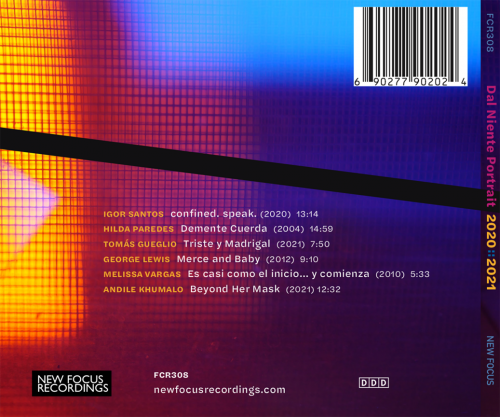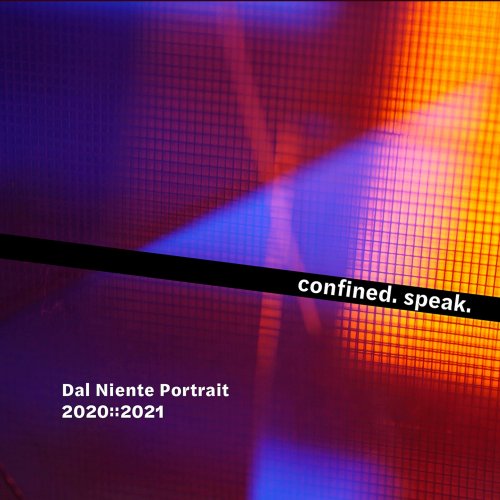
Ensemble Dal Niente - Confined. Speak (2021) Hi-Res
BAND/ARTIST: Ensemble Dal Niente
- Title: Confined. Speak
- Year Of Release: 2021
- Label: New Focus Recordings
- Genre: Classical, Avant-Garde
- Quality: FLAC 16/24 Bit (96 KHz / tracks+booklet)
- Total Time: 63:30 min
- Total Size: 220 / 913 MB
- WebSite: Album Preview

Tracklist:
1. Confined. Speak
2. Demente cuerda
3. Triste y madrigal
4. Merce and Baby
5. Es casi como el inicio...y comienza
6. Beyond Her Mask
Chicago based Ensemble Dal Niente releases confined. speak., a collection of works the group programmed in streaming performances during this past year. Despite the formidable hurdles associated with ensemble playing during the lockdown, Dal Niente presented concerts and took advantage of the ability to collaborate across vast distances. This album chronicles highlights from those events, featuring music by Melissa Vargas, George Lewis, Tomás Gueglio, Hilda Paredes, Igor Santos, and Andile Khumalo that reflects broad geographic influences from South America, North America, and Africa.
As with many new music groups, Chicago based Ensemble Dal Niente drew on deep resources of invention during the last couple of years to continue to present work that channeled our contemporary moment into sound. confined.speak. documents that work, specifically featuring five works that they championed during this period. These works reflect stark dichotomies that shaped these last eighteen months — enforced isolation and restricted movement mixed with a neutralizing of distance and geographic hurdles due to the migration of most activity to the virtual realm. The result is a rich snapshot of one ensemble’s fruitful work in the time of Covid, with composers representing three continents who share a sensibility of digging beneath the expected and discovering a fresh way to manifest forces pulling us in many directions.
Igor Santos’ title track expresses confinement in various ways — through constricted timbres such as the use of mutes, variegated bow pressure techniques, and inside the piano textures; through taut repetitive loops that mechanize the texture; and through a limited pitch language. Watery chord clusters in the piano accompany poignant muted double stops in the violin, an aria echoing off the walls inside one’s own mind.
Hilda Paredes’ kaleidoscopic harp concerto, Demente Cuerda (translated as either “demented string” or “of sound mind”) explores the intersection and divergence between the harp’s delicate timbre and the diverse colors of the ensemble. The work has a rhapsodic spirit, with vibrant, composite instrumental gestures melding together to create sinewy hybrid lines. The ensemble seems to grow out of the lush sound of the harp, indeed creating a large extended hybrid instrument of sorts, shadowing its twists and turns.
Tomás Gueglio’s Triste y madrigal is the first of three works featuring voice on the program. Soprano Amanda DeBoer Bartlett adopts a silvery, quasi-straight tone approach over a murky, ambiguous accompaniment of nocturnal utterances and interjections in the ensemble. This sonic bog gradually becomes more animated and engaged with the foreground melodic material before the texture is suddenly interrupted by an automated voice overlaid with orchestral interludes and voice clips from 1940’s melodrama. The cool, detached quality of the main voice and ensemble material juxtaposed with the nostalgic flashback to a bygone time echoes what many of us experienced during lockdown, a yearning for a richer emotional experience that we could only access through memory.
On Merce and Baby, George Lewis imagines the music that may have resulted from a documented collaboration between choreographer and dancer Merce Cunningham and jazz drummer Baby Dodds. Short imitative gestures bounce through the quartet like bird song, energized by a vigorous, off-kilter percussion part. Embedded within the texture is a microtonal quotation of John Cage’s solo piano work Cheap Imitation. An extended lyrical violin solo passage and subsequent interwoven trio section provides a contrasting energy. By reimagining this historical meeting of the minds, Lewis shines light on one of many fruitful intersections between creative music in the white and black communities that have not been adequately recognized.
.
Melissa Vargas’ Es casi como el inicio... y comienza is written in non-metrical notation, instead orienting the pace of material around a clock timer. Deliberately drawn out instrumental gestures lay a foundation for wild, melismatic syllabic passages in the voice.
Andile Khumalo’s Beyond Her Mask confronts violence against women in his native South Africa. Khumalo used spectral analysis of the percussion instrument the Lion’s Roar and the human voice to generate material for the score. An impactful spoken text is painted by dramatic, coloristic orchestration in the ensemble. Khumalo creates an ethereal, surreal musical landscape, aptly capturing the line in the text, “Reality melts into a symphony of feelings and fleeting moments.” What a resonant image indeed for an album that chronicles a moment in time when our collective reality became suddenly suspended and driven inward.
– Dan Lippel
As with many new music groups, Chicago based Ensemble Dal Niente drew on deep resources of invention during the last couple of years to continue to present work that channeled our contemporary moment into sound. confined.speak. documents that work, specifically featuring five works that they championed during this period. These works reflect stark dichotomies that shaped these last eighteen months — enforced isolation and restricted movement mixed with a neutralizing of distance and geographic hurdles due to the migration of most activity to the virtual realm. The result is a rich snapshot of one ensemble’s fruitful work in the time of Covid, with composers representing three continents who share a sensibility of digging beneath the expected and discovering a fresh way to manifest forces pulling us in many directions.
Igor Santos’ title track expresses confinement in various ways — through constricted timbres such as the use of mutes, variegated bow pressure techniques, and inside the piano textures; through taut repetitive loops that mechanize the texture; and through a limited pitch language. Watery chord clusters in the piano accompany poignant muted double stops in the violin, an aria echoing off the walls inside one’s own mind.
Hilda Paredes’ kaleidoscopic harp concerto, Demente Cuerda (translated as either “demented string” or “of sound mind”) explores the intersection and divergence between the harp’s delicate timbre and the diverse colors of the ensemble. The work has a rhapsodic spirit, with vibrant, composite instrumental gestures melding together to create sinewy hybrid lines. The ensemble seems to grow out of the lush sound of the harp, indeed creating a large extended hybrid instrument of sorts, shadowing its twists and turns.
Tomás Gueglio’s Triste y madrigal is the first of three works featuring voice on the program. Soprano Amanda DeBoer Bartlett adopts a silvery, quasi-straight tone approach over a murky, ambiguous accompaniment of nocturnal utterances and interjections in the ensemble. This sonic bog gradually becomes more animated and engaged with the foreground melodic material before the texture is suddenly interrupted by an automated voice overlaid with orchestral interludes and voice clips from 1940’s melodrama. The cool, detached quality of the main voice and ensemble material juxtaposed with the nostalgic flashback to a bygone time echoes what many of us experienced during lockdown, a yearning for a richer emotional experience that we could only access through memory.
On Merce and Baby, George Lewis imagines the music that may have resulted from a documented collaboration between choreographer and dancer Merce Cunningham and jazz drummer Baby Dodds. Short imitative gestures bounce through the quartet like bird song, energized by a vigorous, off-kilter percussion part. Embedded within the texture is a microtonal quotation of John Cage’s solo piano work Cheap Imitation. An extended lyrical violin solo passage and subsequent interwoven trio section provides a contrasting energy. By reimagining this historical meeting of the minds, Lewis shines light on one of many fruitful intersections between creative music in the white and black communities that have not been adequately recognized.
.
Melissa Vargas’ Es casi como el inicio... y comienza is written in non-metrical notation, instead orienting the pace of material around a clock timer. Deliberately drawn out instrumental gestures lay a foundation for wild, melismatic syllabic passages in the voice.
Andile Khumalo’s Beyond Her Mask confronts violence against women in his native South Africa. Khumalo used spectral analysis of the percussion instrument the Lion’s Roar and the human voice to generate material for the score. An impactful spoken text is painted by dramatic, coloristic orchestration in the ensemble. Khumalo creates an ethereal, surreal musical landscape, aptly capturing the line in the text, “Reality melts into a symphony of feelings and fleeting moments.” What a resonant image indeed for an album that chronicles a moment in time when our collective reality became suddenly suspended and driven inward.
– Dan Lippel
Year 2021 | Classical | FLAC / APE | HD & Vinyl
As a ISRA.CLOUD's PREMIUM member you will have the following benefits:
- Unlimited high speed downloads
- Download directly without waiting time
- Unlimited parallel downloads
- Support for download accelerators
- No advertising
- Resume broken downloads


